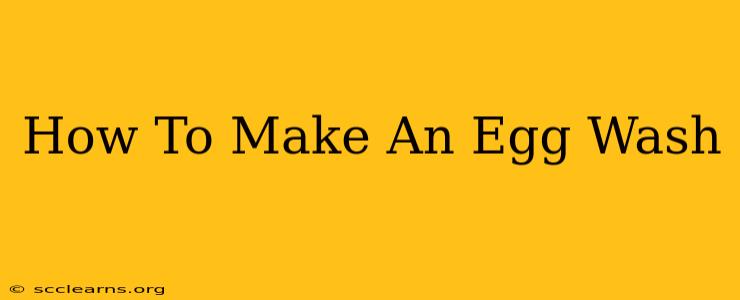Want to achieve that irresistible golden-brown crust on your pastries, breads, and pies? Look no further than the humble egg wash! This simple technique adds a beautiful sheen and enhances the flavor of your baked goods. This guide will walk you through everything you need to know about making the perfect egg wash, ensuring your creations are not only delicious but also visually stunning.
What is an Egg Wash?
An egg wash is simply a mixture of beaten eggs (or egg yolks) and a liquid, usually water or milk. This mixture is brushed onto the surface of baked goods before baking, creating a glossy finish and helping them brown beautifully. The protein in the egg helps the surface set, resulting in a richer color and a more appealing texture.
Why Use an Egg Wash?
There are several compelling reasons to incorporate an egg wash into your baking routine:
- Enhanced Browning: The egg wash promotes Maillard reactions, which are responsible for the delicious browning and flavor development on the surface of baked goods.
- Glossy Finish: The egg wash creates a beautiful, glossy sheen that elevates the visual appeal of your creations.
- Improved Texture: The egg wash helps create a slightly firmer crust, adding another layer of textural complexity.
- Flavor Enhancement: While subtle, the egg wash can contribute a slightly richer flavor to your baked goods.
How to Make an Egg Wash: A Step-by-Step Guide
Making an egg wash is incredibly straightforward. Here's a simple recipe:
Ingredients:
- 1 large egg (or 1-2 egg yolks for a richer color)
- 1 tablespoon of water or milk (or a combination of both)
Instructions:
- Crack the egg: Carefully crack the egg into a small bowl.
- Whisk: Use a fork to whisk the egg vigorously until it's light and frothy. Any remaining bits of egg white should be fully incorporated. For a richer, more golden-brown color, use only the egg yolks.
- Add liquid: Gently whisk in the water or milk until the mixture is evenly combined. The consistency should be smooth and slightly thin. Don't over-whisk, as this can incorporate too much air and lead to an uneven finish.
- Strain (optional): For an extra smooth finish, strain the egg wash through a fine-mesh sieve to remove any bits of egg white. This is especially helpful when using only egg yolks.
Tips for the Perfect Egg Wash
- Room Temperature: Using room-temperature eggs will result in a smoother, more easily blended wash.
- Don't Over-Whisk: Over-whisking can incorporate too much air, leading to an uneven finish.
- Brushing Technique: Use a pastry brush to gently apply the wash to the surface of your baked goods. Avoid heavy applications; a thin, even layer is best.
- Timing: Apply the egg wash just before baking for optimal browning.
- Experiment with Flavor: For added flavor, consider adding a pinch of salt or a teaspoon of vanilla extract to your egg wash.
Variations of Egg Wash
While the basic egg wash recipe is incredibly versatile, you can experiment with variations to achieve different results:
- Milk Wash: Replace water with milk for a slightly richer and creamier wash.
- Cream Wash: Use heavy cream instead of milk for an even richer, glossier finish.
- Egg Yolk Wash: For a deep golden-brown color, use only egg yolks.
Troubleshooting
- Uneven Browning: This could be due to uneven application of the egg wash or an inconsistent oven temperature.
- Too Much Browning: Reduce the amount of egg wash applied or reduce baking time.
- Wash is too thick: Add a little more water or milk to thin it out.
Mastering the art of the egg wash is a simple yet effective way to elevate your baking skills. With a little practice, you'll be creating beautifully browned, golden-crusted baked goods that are sure to impress. So grab those eggs and get baking!

